Air India
 | |||||||
| |||||||
| Founded | 15 October 1932 (as Tata Airlines) | ||||||
|---|---|---|---|---|---|---|---|
| Commenced operations | 29 July 1946[1] | ||||||
| Hubs | Indira Gandhi International Airport | ||||||
| Secondary hubs | Chhatrapati Shivaji International Airport | ||||||
| Frequent-flyer program | Flying Returns | ||||||
| Airport lounge | Maharaja Lounge | ||||||
| Alliance | Star Alliance | ||||||
| Subsidiaries | |||||||
| Fleet size | 108 | ||||||
| Destinations | 86 | ||||||
| Company slogan | Air India... Truly Indian | ||||||
| Parent company | Air India Limited | ||||||
| Headquarters | Airlines House, Delhi, India[2] | ||||||
| Key people | Ashwani Lohani, Chairman and MD[3] | ||||||
| Revenue |
| ||||||
| Operating income |
| ||||||
| Net income |
| ||||||
| Employees | 20,956 (November 2016) | ||||||
| Website |
www | ||||||
Air India is the flag carrier airline of India[6] and the third-largest airline in India in terms of passengers carried, after IndiGo and Jet Airways. It is owned by Air India Limited, a Government of India enterprise, and operates a fleet of Airbus and Boeing aircraft serving 85 domestic and international destinations. It is headquartered in New Delhi. Air India has its main hub at Indira Gandhi International Airport, New Delhi and a secondary hub at Chhatrapati Shivaji International Airport, Mumbai. Air India became the 27th member of Star Alliance on 11 July 2014.
The airline was founded by J. R. D. Tata as Tata Airlines in 1932; Tata himself flew its first single-engine de Havilland Puss Moth, carrying air mail from Karachi to Bombay's Juhu aerodrome and later continuing to Madras (currently Chennai). After World War II, it became a public limited company and was renamed as Air India. On 21 February 1960, it took delivery of its first Boeing 707–420 named Gauri Shankar and became the first Asian airline to induct a jet aircraft in its fleet.[7] In 2000–01, attempts were made to privatize Air India and from 2006 onwards, it suffered losses after its merger with Indian Airlines.
Air India also operates flights to domestic and Asian destinations through its subsidiaries Air India Regional and Air India Express. Air India uses the Airbus A320 family and Boeing 787 aircraft for selected domestic routes while long distance services use the Boeing 777-300ER, 747 and 787 aircraft. Air India's mascot is the Maharajah (Emperor) and the logo consists of a flying swan with the wheel of Konark inside it.
History
Early years (1932–1945)
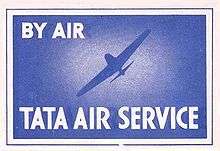
Air India had its origin in Tata Sons, founded by J. R. D. Tata, an Indian aviator and business tycoon.[8] In April 1932, Tata won a contract to carry mail for Imperial Airways and the aviation department of Tata Sons was formed with two single-engine de Havilland Puss Moths. On 15 October 1932, Tata flew a Puss Moth carrying air mail from Karachi to Bombay (currently Mumbai) and the aircraft continued to Madras (currently Chennai) piloted by Nevill Vintcent, a former Royal Air Force pilot and friend of Tata.[9] The airline fleet consisted of a Puss Moth aircraft and a Leopard Moth.[10][11] Initial service included weekly airmail service between Karachi and Madras via Ahmedabad and Bombay. In its first year of operation, the airline flew 160,000 miles (260,000 km), carrying 155 passengers and 9.72 tonnes (10.71 tons) of mail and made a profit of ₹60,000 (US$890).[12][13] Later, the airline launched a domestic flight from Bombay to Trivandrum with a six-seater Miles Merlin.[14] In 1938, it was re-christened as Tata Air Services and later as Tata Airlines. Delhi and Colombo were added to the destinations in 1938.[9] During the Second World War, the airline helped the Royal Air Force with troop movements, shipping of supplies, rescue of refugees and maintenance of planes.[9]
Post Independence (1946–2000)

After World War II, regular commercial service was restored in India and Tata Airlines became a public limited company on 29 July 1946 under the name Air India.[1] After the Indian independence in 1947, 49% of the airline was acquired by the Government of India in 1948.[15] On 8 June 1948, a Lockheed Constellation L-749A named Malabar Princess (registered VT-CQP) took off from Bombay bound for London Heathrow marking the airline's first international flight.[9] In 1953, the Government of India passed the Air Corporations Act and purchased a majority stake in the carrier. The company was renamed as Air India International Limited and the domestic services were transferred to Indian Airlines as a part of restructuring.[16] From 1948 to 1950, the airline introduced services to Nairobi in Africa and to major European destinations Rome, Paris and Düsseldorf.[17] The airline took delivery of its first Lockheed Constellation L-1049 named Rani of Jhansi (registered VT-DGL) and inaugurated services to Bangkok, Hong Kong, Tokyo and Singapore.[17]
On 21 February 1960, Air India International inducted its first Boeing 707–420 named Gauri Shankar (registered VT-DJJ), thereby becoming the first Asian airline to induct a jet aircraft in its fleet.[18][19] The airline inaugurated services to New York on 14 May 1960.[17] On 8 June 1962, the airline's name was officially truncated to Air India[1] and on 11 June 1962, Air India became the world's first all-jet airline. In 1971, the airline took delivery of its first Boeing 747-200B named Emperor Ashoka (registered VT-EBD)[20] and introduced a new Palace in the Sky livery and branding. In 1986, Air India took delivery of its first Airbus A310-300.[17] In 1993, Air India took delivery of a Boeing 747-400 named Konark (registered VT-ESM) and operated the first non-stop flight between New York and Delhi.[21]
Later years (2000–)
_Airbus_A310-300_Durand.jpg)
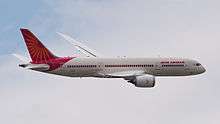

In 2000–01, attempts were made to re-privatize Air India.[22][23][24][25] In 2000, Air India introduced services to Shanghai, China. On 23 May 2001, the Ministry of Civil Aviation charged Michael Mascarenhas, the then-managing director, with corruption. According to the ministry reports, the airline lost approximately ₹570 million (US$8.5 million) because of extra commissions that Mascarenhas sanctioned and he was later suspended from the airline.[26] In May 2004, Air India launched a wholly owned low cost subsidiary called Air-India Express connecting cities in India with the Middle East and Southeast Asia. Until 2007, Air India mainly operated on international long-haul routes while Indian Airlines operated on domestic and international short-haul routes. In 2007, Air India and Indian Airlines were merged under Air India Limited[27] and the airline took delivery of its first Boeing 777 aircraft.[17] The airline was invited to be a part of the Star Alliance in 2007.[28]
The combined losses for Air India and Indian Airlines in 2006–07 were ₹7.7 billion (US$110 million) and after the merger, it went up to ₹72 billion (US$1.1 billion) by March 2009.[29][30] In July 2009, State Bank of India was appointed to prepare a road map for the recovery of the airline.[31] The carrier sold three Airbus A300 and one Boeing 747–300M in March 2009 for $18.75 million to finance the debt.[32] By March 2011, Air India had accumulated a debt of ₹425.7 billion (US$6.3 billion) and an operating loss of ₹220 billion (US$3.3 billion), and was seeking ₹429.2 billion (US$6.4 billion) from the government.[33][34] A report by the Comptroller and Auditor General blamed the decision to buy 111 new planes and the ill-timed merger with Indian Airlines for the poor financial situation.[35][36] In August 2011, the invitation to join Star Alliance was suspended as a result of its failure to meet the minimum standards for the membership.[37][38] The government pumped ₹32 billion (US$480 million) into Air India in March 2012.[39][40]
On 1 March 2009, Air India made Frankfurt Airport its international hub for onward connections to the United States from India. However, the airline shut down the Frankfurt hub on 30 October 2010 because of high operating costs.[41] In 2010, financially less lucrative routes were terminated and the airline planned to open a new hub for its international flights at Dubai.[42] In 2012, a study commissioned by the Corporate Affairs Ministry recommended that Air India should be partly privatized.[43] In May 2012, the carrier invited offers from banks to raise up $800 million via external commercial borrowing and bridge financing.[44] In May 2012, the airline was fined $80,000 by the U.S. Transportation Department for failing to post customer service and tarmac delay contingency plans on its website and adequately inform passengers about its optional fees.[45]
In 2013, the then-Civil Aviation Minister Ajit Singh stated privatization was the key to the airline's survival.[46] However, the opposition led by the BJP and the CPI(M) slammed the government.[47] In 2013, the Indian government planned to delay equity infusion of ₹300 billion (US$4.5 billion) that was slated to be infused into the airline slowly over a period of eight years.[48] In January 2013, Air India cleared a part of its pending dues through funds raised by selling and leasing back the newly acquired Boeing 787 Dreamliners.[49][50] In March 2013, the airline posted its first positive EBITDA after almost six years and 20% growth in its operating revenue since the previous financial year.[51][52] Air India Limited split its engineering and cargo businesses into two separate subsidiaries, Air India Engineering Services Limited (AIESL) and Air India Transport Services Limited (AITSL) in 2013.[53][54] In December 2013, the airline appointed veteran pilot SPS Puri as its head of operations. The appointment was criticized by the Air India pilots union as Puri allegedly has multiple violations to his name.[55]
Air India became the 27th member of Star Alliance on 11 July 2014.[56][57] In August 2015, it signed an agreement with Citibank and State Bank of India to raise $300 million in external commercial borrowing to meet working capital requirements.[3] For FY 2014–15, its revenue, operating loss and net loss were ₹197.81 billion (US$2.9 billion), ₹2.171 billion (US$32 million) and ₹5.41 billion (US$80 million) compared FY 2011–12, which were ₹147.13 billion (US$2.2 billion), ₹5.138 billion (US$76 million) and ₹7.55 billion (US$110 million).[5][58] As of February 2016, Air India is the third largest carrier in India, after IndiGo and Jet Airways with a market share of 15.4%.[59][60][61][62]
Corporate affairs and identity
Headquarters
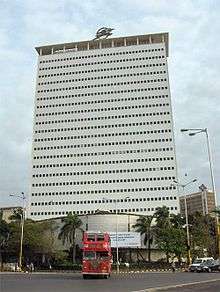
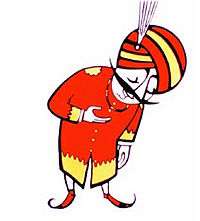

Air India Limited is headquartered at the Indian Airlines House, New Delhi.[2][63] Air India moved its headquarters from Air India Building, Mumbai to Delhi in 2013. The former headquarters is a 23-storey tower on Marine Drive and was one of the targets of the 1993 Bombay bombings.[2][64]
Subsidiaries
Current
Air India Regional was established as Alliance Air, a wholly owned subsidiary of Indian Airlines on 1 April 1996 and started operations on 21 June 1996. It was renamed Air India Regional after the merger between Air India and Indian Airlines.[65] Air India Express began operations on 29 April 2005 and was initially owned by Air India Charters. It operates flights from South India to the Middle East and Southeast Asia.[66][67]
Defunct
Air India became the first Asian airline to operate freighters when Air India Cargo was set up in 1954 and started its freighter operations with a Douglas DC-3 aircraft.[17] Air India Cargo ended freighter aircraft operations in early 2012.[68]
Mascot
Air India's mascot is the Maharajah (Emperor).[69][70] It was created by Bobby Kooka, the then-commercial director of Air India, and Umesh Rao, an artist with J. Walter Thompson Limited in 1946.[71] Kooka stated that, "We call him a Maharajah for want of a better description. But his blood isn't blue. He may look like royalty, but he isn't royal".[72] Air India adopted the Maharajah as its mascot in 1946. It was used in promoting it although initially designed only for the airline's memo-pads.[73] The Maharajah was given a makeover in 2015 and the brand is represented by a younger version.[74]
Logo and livery
Air India's colour scheme is red and white. The aircraft were painted in white with red palace style carvings on the outside of the windows and the airline's name written in red. The name is written in Hindi on one side and in English on the other.[75] The window scheme was designed in line with the slogan Your Palace in the Sky.[17] The airplanes were earlier named after Indian kings and landmarks. In 1989, to supplement its Flying Palace livery, Air India introduced a new livery that included a metallic gold spinning wheel on a deep red-coloured tail and a Boeing 747, Rajendra Chola, was the first aircraft to be painted in the new colours.[17]
The first logo of Air India was a centaur, a stylised version of Sagittarius shooting an arrow in a circle representing the wheel of Konark. The logo chosen by founder J. R. D. Tata was introduced in 1948 and represented the airline until 2007.[76] On 22 May 2007, Air India and Indian Airlines unveiled their new livery consisting of a Flying Swan with the wheel of Konark placed inside it. The flying swan was morphed from the centaur logo and the chakra was derived from Indian's erstwhile logo.[77] On 15 May 2007, Air India refreshed its livery, making the Rajasthani arches along the windows slightly smaller, extending a stylised line from the tail of the aircraft to the nose and painting the underbelly red. The new logo features on the tail and the engine covers with red and orange lines running parallel to each other from the front door to the rear door.[70]
Destinations
Air India flies to a total of 86 destinations including 49 domestic destinations and 37 international destinations in 26 countries across four continents around the world.[78] Its primary hub is located at Indira Gandhi International Airport, New Delhi, and it has a secondary hub at Chhatrapati Shivaji International Airport, Mumbai.[79]
As of October 2016, Air India operates the world's longest nonstop regular scheduled commercial flight, from Delhi to San Francisco flying over the Pacific Ocean, with the total distance flown being over 15,200 kilometres (9,400 mi). Services between the two cities previously operated over the Atlantic Ocean in both directions; the airline changed the service to around-the-world to take advantage of jet stream winds and use less fuel.[80]
Alliance
Air India became the 27th member of Star Alliance on 11 July 2014.[56][57]
Codeshare agreements
Air India codeshares with the following airlines:[81][82]
Fleet
Current
As of December 2016, the Air India fleet consists of the following aircraft:[83]
| Aircraft | In Service | Orders | Passengers | Notes | |||
|---|---|---|---|---|---|---|---|
| F | J | Y | Total | ||||
| Airbus A319-100 | 22 | — | — | 8 | 114 | 122 | |
| — | — | 144 | 144 | ||||
| Airbus A320-200 | 24 | — | — | — | 168 | 168 | |
| — | 12 | 138 | 150 | ||||
| Airbus A320neo | — | 14 | — | 12 | 150 | 162[84] | Deliveries scheduled to begin January 2017[85][86] |
| Airbus A321-200 | 20 | — | — | 12 | 170 | 182 | |
| Boeing 747-400 | 4 | — | 12 | 26 | 385 | 423 | |
| Boeing 777-200LR | 3 | — | 8 | 35 | 195 | 238 | |
| Boeing 777-300ER | 12 | 3 | 4 | 35 | 303 | 342 | |
| Boeing 787-8 | 22 | 5 | — | 18 | 238 | 256 | |
| Total | 108 | 22 | |||||
Fleet information

In 1932, Air India started operations with De Havilland Puss Moth. It inducted its first Boeing 707–420 named Gauri Shankar (registered VT-DJJ), thereby becoming the first Asian airline to induct a jet aircraft in its fleet and on 4 August 1993, Air India took the delivery of its first Boeing 747–400 named Konark (registered VT-ESM).[87] The airline's first Boeing 777-200LR aircraft was delivered on 26 July 2007, which was named Andhra Pradesh.[88] Air India received its first Boeing 777-300ER aircraft on 9 October 2007 and the aircraft was named as Bihar.[89] Air India received its first Boeing 787 dreamliner aircraft on 6 September 2012 and commenced flights on 19 September 2012.[90]
Apart from the Boeing aircraft, Air India also operates a wide range of Airbus aircraft. In 1989, Indian Airlines introduced the Airbus A320-200 aircraft, which Air India now uses to operate both domestic and international short haul flights.[17] In 2005, Indian Airlines introduced the smaller, A319, which are now used mainly on domestic and regional routes.[17] After the merger in 2007, Air India inducted the biggest member of the A320 family, the A321, to operate mainly on international short haul and medium haul routes. At the same time, Air India leased the Airbus A330s to operate on medium-long haul international routes. As of February 2013, Air India operates 62 Airbus A320 family aircraft. Air India One (also referred to as AI-1 or AIC001) is the call sign of any Air India aircraft carrying the Prime Minister, President or the Vice President.[91][92] Air India One operates on one of the five Boeing 747-400s that Air India currently owns as VIP flights. Customised Embraer 135 and Boeing Business Jets are also used.[93][94][95]
New aircraft orders
.jpg)
On 11 January 2006, Air India announced an order for 68 jets – 8 Boeing 777-200LR, 15 Boeing 777-300ER, 18 Boeing 737-800 and 27 Boeing 787-8 Dreamliners. The eighteen Boeing 737s ordered were later transferred to Air India Express. Air India has taken the delivery of 20 Boeing 787–8s as of December 2015 and the remaining are expected to be delivered by 2016.[96]
Fleet restructuring
As a part of the financial restructuring, Air India sold five of its eight Boeing 777-200LR aircraft to Etihad Airways in December 2013. According to the airline, plans for introducing ultra-long flights with service to Seattle, San Francisco and Los Angeles were cancelled due to factors like high fuel prices and weak demand.[97] In April 2014, the airline decided to sell its remaining three Boeing 777-200LRs as well, citing higher operating costs.[98] On 24 April 2014, Air India issued a tender for leasing 14 Airbus A320 aircraft for up to six years, to strengthen its domestic network.[99]
Formerly operated
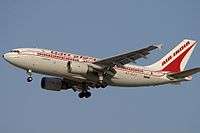
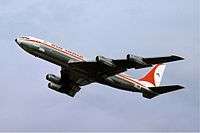


|
Apart from the aircraft listed above, Air India operated several other aircraft. Air India operated the de Havilland Puss Moth, de Havilland Fox Moth, Waco YQC-6, de Havilland Dragon Rapide, Percival Petrel, Douglas DC-2, Douglas DC-3, Vickers VC.1 Viking, Lockheed L-749 Constellation, Douglas DC-4 and the Lockheed L-1049 Super Constellation up to 1960. Thereafter, Air India started operating the Boeing 707 and the de Havilland Comet.[101]
Services
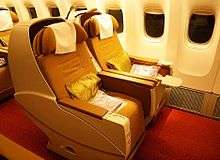

Cabin
The Boeing 777-200LR/777-300ER aircraft operated on long haul flights can accommodate 342 passengers in a three class configuration viz. first (3), business (35) and economy (303).[102] The Boeing 747–400 can accommodate 423 passengers in the same three class configuration in a 12-26-385 seating arrangement.[103] Boeing 787 Dreamliner and Airbus A321 flights have a two class configuration and can accommodate 256 (18B/238E) and 172 (20B/152E) passengers.[104][105] Airbus A320 aircraft operated on domestic and short haul international flights can accommodate either 168 in economy configuration or 140 (20B/120E) in a two class configuration.[106][107] Airbus A319 aircraft have a full economy 144 seat configuration.[108] Air India serves meals on all international flights and domestic flights with a flight duration of over 90 minutes.[109]
In-flight entertainment
Air India aircraft are equipped with Thales i3000 in-flight entertainment system. Passengers can choose from five channels airing Hindi and English content.[110] Air India's Boeing 777 series, 747 and 787 aircraft are also equipped with personal on demand in-flight entertainment systems on which passengers can choose from available content.[111] Showtime is the official entertainment guide published by Air India. Shubh Yatra (meaning Happy Journey) is a bilingual in-flight magazine published in English and Hindi by Air India.[112]
Frequent flyer programme
Flying Returns is Air India's frequent-flyer programme. It is India's first frequent flyer programme and is shared by Air India and its subsidiaries. A member can earn mileage points and redeem them during future travel. On higher fares, passengers will earn bonus miles and clock mileage points. The points can be redeemed for awards travel on Lufthansa and Singapore Airlines.[113]
Premium lounges
The Maharaja Lounge (English: Emperor's Lounge) is available for the use of First and Business class passengers. Air India shares lounges with other international airlines at international airports that do not have a Maharaja Lounge available.[114] There are eight Maharaja Lounges:[115]
- India
- Chhatrapati Shivaji International Airport, Mumbai
- Indira Gandhi International Airport, Delhi
- Chennai International Airport, Chennai
- Kempegowda International Airport, Bangalore
- Rajiv Gandhi International Airport, Hyderabad
- Sardar Vallabhbhai Patel International Airport, Ahmedabad
- International
Awards and recognitions
- Preferred International Airline for travel and hospitality from Awaz Consumer Awards (2006)[116]
- Best Corporate Social Responsibility Initiative by Galileo Express Travel World[117]
- Best Short-Haul International Airline by Galileo Express Travel World (2008)[117]
- Amity Corporate Excellence Award by Amity University [117]
- Reader's Digest Trusted Brand[117]
- Dun and Bradstreet Award (D&B), first in terms of revenue out of the top airline companies out of India[117]
- Best South Asian Airline, Mice and business travel publications[117]
- Cargo Airline of the Year, 26th Cargo Airline of the Year Awards[118]
- The Montreal Protocol Public Awareness Award by the United Nations for environmental protection[119]
- Air India was named India's most trusted airline by The Brand Trust Report 2015.[120]
- Air India was chosen as India's Most Reputed Airline in a consumer and media research in July 2016 by Bluebytes News [121] and TRA Research [122][123]
Air India's ground services became the first ground service provider to acquire ISO 9002 certification on 31 January 2001.[124][125]
Gulf War evacuation
The airline entered the Guinness Book of World Records for the most people evacuated by a civil airliner.[126] Over 111,000 people were evacuated from Amman to Mumbai, a distance of 4,117 kilometres (2,558 mi), by operating 488 flights from 13 August to 11 October 1990 – lasting 59 days. The operation was carried out during Persian Gulf War to evacuate Indian expatriates from Kuwait and Iraq.[126][127][128][129]
Accidents and incidents
1940s
- On 27 December 1947, an Air India DC-3 (registered VT-AUG) carrying 23 people (19 passengers and four crew) en route from Karachi to Bombay, lost control after take-off from Karachi International Airport due to an instrument failure and crashed, killing all on board. This was the airline's first fatal accident.[130]
1950s
- On 3 November 1950, Air India Flight 245 Malabar Princess, a Lockheed L-749 Constellation (registered VT-CQP) carrying 48 people (40 passengers and eight crew), flying on the Bombay-Cairo-Geneva-London route, crashed on Mont Blanc in France killing all on board.[131][132]
- On 13 December 1950, an Air India DC-3 (registered VT-CFK) carrying 21 people (17 passengers and four crew), en route from Bombay to Coimbatore, crashed into high ground near Kotagiri due to a navigational error, killing all on board.[133]
- On 15 September 1951, an Air India Douglas C-47 Skytrain (registered VT-CCA) carrying 27 people (23 passengers and four crew) en route from Bangalore to Trivandrum, crashed on take-off killing a crew member.[134]
- On 9 May 1953, an Air India Douglas C-47 Skytrain (registered VT-AUD) carrying 18 people (13 passengers and five crew) crashed after take-off from Delhi killing all on board.[135]
- On 11 April 1955, Kashmir Princess, a Lockheed L-749A Constellation (registered VT-DEP) carrying 19 people (11 passengers and 8 crew) was bombed in mid-air, killing 16 of the 19 on board.[136][137]
- On 19 July 1959 Rani of Aera, a Lockheed L-1049G Super Constellation (registered VT-DIN) carrying 46 people (39 passengers and seven crew) crashed on approach to Santacruz Airport in conditions of poor visibility due to rain. The aircraft suffered damage beyond repair and was written off. There were no fatalities.[138]

1960s
- On 24 January 1966, Air India Flight 101 Kanchenjunga, a Boeing 707–420 (registered VT-DMN) carrying 117 people (106 passengers and 11 crew) crashed on Mont Blanc, France killing all on board including the noted Indian scientist, Homi J. Bhabha.[139]
1970s
- On 1 January 1978, Air India Flight 855 Emperor Ashoka, a Boeing 747-237B (registered VT-EBD) crashed into the Arabian Sea after take-off from Mumbai killing everyone on board (213 persons; 190 passengers, 23 crew).[20]
1980s
- On 21 June 1982, Air India Flight 403 Gouri Shankar, a Boeing 707–420 (registered VT-DJJ) carrying 99 passengers and 12 crew from Kuala Lumpur to Bombay via Madras crashed during landing at Sahar International Airport during a rainstorm. The fuselage exploded and 17 people including two crew members were killed.[140][141]
- On 23 June 1985, Air India Flight 182 Emperor Kanishka, a Boeing 747-237B (registered VT-EFO) was blown up in mid-air by a suitcase-bomb planted by Babbar Khalsa terrorists allegedly as revenge for the Indian Government's operation on the Golden Temple in June 1984. The flight was on the first leg on its Montreal-London-Delhi-Bombay flight when it exploded off the coast of Cork, Ireland in the Atlantic Ocean. All 307 passengers and 22 crew on board died.[142]
1990s
- On 7 May 1990, Air India Flight 132 Emperor Vikramaditya, a Boeing 747-237B (registered VT-EBO) flying on the London-Delhi-Bombay route carrying 215 people (195 passengers and 20 crew) caught fire on touch down at Delhi airport due to a failure of an engine pylon to wing attachment. There were no fatalities but the aircraft was damaged beyond repair and written off.[143]
See also
References
- 1 2 3 "Air India, Indian airline". Britannica. Retrieved 6 March 2016.
- 1 2 3 Upadhyay, Anindya (15 February 2013). "Air India vacates Nariman Point; moves headquarters to Delhi". The Economic Times. Retrieved 16 February 2013.
- 1 2 3 4 "Can Ashwani Lohani turn Air India around?". Business Standard. 14 September 2015. Retrieved 6 December 2015.
- ↑ Mishra, Mihir (14 October 2016). "Air India makes operating profit of Rs 105 crore". Retrieved 16 October 2016.
- 1 2 "Air India likely to suffer 2636 crore net loss in 2015-16". 28 April 2016. Retrieved 16 October 2016.
- ↑ "Flying low; India's flag carrier is in big trouble". The Economist. 21 July 2012. Retrieved 15 October 2016.
- ↑ "Air India : The History of The Aircraft Fleet - Airwhiners.net". www.airwhiners.net. Retrieved 15 July 2016.
- ↑ "Airline Companies of the World". Flight International. 27 April 1939. Retrieved 17 September 2011.
- 1 2 3 4 "How Maharaja got his wings". Tata Sons. Retrieved 7 March 2016.
- ↑ Seth, Pran Nath; Bhat, Sushma Seth (2005). An introduction to travel and tourism. Sterling Publishers. ISBN 978-81-207-2482-2.
- ↑ Behari, Bapu (1996). Astrological Biographies: Seventeen Examples of Predictive Insights. Motilal Banarsidass. ISBN 978-81-208-1322-9.
- ↑ "Switzerland Schweiz Suisse Svizzera". Air India. Archived from the original on 11 August 2012. Retrieved 13 September 2012.
- ↑ Subramanian, Samanth (15 October 2012). "When Air India Was Efficient, Profitable and Growing Fast". The New York Times. Retrieved 24 March 2013.
- ↑ "Humane Face of IAF: Aid to the Civil Administration" (PDF). Medind.nic.in. Retrieved 1 October 2012.
- ↑ Air Transport Inquiry Committee. Report of the Air Transport Inquiry Committee, 1950. University of California. p. 28.
- ↑ "Air Corporations Act, 1953" (PDF). Government of India. DGCA. Retrieved 6 March 2016.
- 1 2 3 4 5 6 7 8 9 10 "Timeline: Air India". Air India. Retrieved 2 April 2014.
- ↑ Sabharwal, Gopa (2007). India Since 1947: The Independent Years. Penguin India. p. 77. ISBN 978-0-14-310274-8.
- ↑ Sean Mendis. "Air India : The history of the aircraft fleet". Retrieved 2 April 2014.
- 1 2 "Theory on Air India Crash Backed by a Pilot". The New York Times. 21 April 1985. Retrieved 6 March 2016.
- ↑ Jethmalani, Ram. "The dying Maharaja's last sigh". Sunday Guardian. Retrieved 6 March 2016.
- ↑ "India privatisation plans near 'collapse'". BBC. 3 September 2001. Retrieved 23 April 2010.
- ↑ "Tata still eyeing Air India". BBC. 3 September 2001. Retrieved 6 March 2016.
- ↑ "Singapore Airlines pulls out". The Hindu. 2 September 2001. Retrieved 6 March 2016.
- ↑ Timmons, Heather (25 May 2011). "Criticism of State-Owned Air India Grows". The New York Times. Retrieved 20 May 2012.
- ↑ Katakam, Anupama (21 April 2014). "Controversy in the air". Frontline. Retrieved 6 March 2016.
- ↑ "National Aviation Company of India Limited" (PDF). Air India. Archived (PDF) from the original on 20 April 2013. Retrieved 18 February 2013.
- ↑ "Star Alliance invites Air India to join". The Economic Times. 13 December 2007. Retrieved 23 March 2014.
- ↑ "What sent Air India crashing?". The Economic Times. 16 July 2009. Retrieved 30 August 2010.
- ↑ "Air India restructuring plans being readied". The Hindu. Chennai, India. 9 July 2009. Retrieved 30 August 2010.
- ↑ "SBI Caps prepares roadmap for Air India restructuring". DNA India. 22 July 2009. Retrieved 30 August 2010.
- ↑ "AI sells 4 aircraft in Mar to tackle financial crunch". Financial Express. 29 July 2009. Retrieved 30 August 2010.
- ↑ "Air India's recurring default 'credit negative' for its banks". Mint-Wall Street Journal. 9 August 2011.
- ↑ "State Bank of India Credit Rating". Moodys.com. Retrieved 1 October 2012.
- ↑ "Air India aircraft acquisition was necessary". Malayala Manorama. 8 September 2011. Retrieved 6 March 2016.
- ↑ Choudhury, Santanu (8 September 2011). "Auditor Slams Air India Plane Orders". The Wall Street Journal. Retrieved 6 March 2016.
- ↑ "Star Alliance and Air India put Air India's Alliance Membership Application on hold" (PDF) (Press release). Star Alliance. 31 August 2011. Archived from the original (PDF) on 28 March 2012. Retrieved 31 August 2011.
- ↑ "Air India, Star Alliance resume talks". Hindustan Times. 13 October 2011. Archived from the original on 16 December 2011. Retrieved 15 October 2011.
- ↑ Sundaram, Karthikeyan; Narayan, Adi (14 March 2012). "Air India Aid Dwarfing Hospital Budget Adds to Kingfisher Pain". Bloomberg.
- ↑ "Air India: Problems run deep in India's national airline". BBC. 16 May 2012. Retrieved 6 March 2016.
- ↑ "Air India to use Terminal-3 as hub of operations". NDTV. 14 July 2010. Archived from the original on 18 July 2010. Retrieved 12 August 2010.
- ↑ "Dubai in talks over hub". thenational.ae. Retrieved 5 November 2015.
- ↑ "Air India should be partly privatised, says study". The Economic Times. 30 September 2012. Retrieved 6 March 2016.
- ↑ Reuters (8 May 2012). "Air India seeks proposals to raise up to $800 million in debt". The Economic Times. Retrieved 6 March 2016.
- ↑ "$80,000 Fine Slapped on Air India by US". Outlook. 4 May 2012. Retrieved 6 March 2016.
- ↑ "Air India must perform or perish: Civil Aviation Minister Ajit Singh". NDTV. 6 October 2013. Retrieved 6 March 2016.
- ↑ Mehdudia, Sujay (7 October 2013). "Opposition slams Ajit Singh for AI plan". The Hindu. Chennai, India. Retrieved 6 March 2016.
- ↑ "Debt laden Air India unlikely to get government bailout of Rs 30,000 crore by 2020–21". The Economic Times. 11 February 2013. Retrieved 11 February 2013.
- ↑ "GMR Infra gets Rs 415 cr in outstanding dues from Air India". Business Today. 7 February 2013. Retrieved 8 February 2013.
- ↑ "Air India puts Dreamliner planes for sale, leaseback". The Economic Times. 28 January 2013. Retrieved 28 January 2013.
- ↑ "Air India likely to end fiscal with Rs 65 crore positive EBITDA". The Economic Times. 10 March 2013. Retrieved 6 March 2016.
- ↑ "Significant improvements in Air India's performance parameters". The Economic Times. 1 April 2014. Retrieved 4 April 2014.
- ↑ "Air India engineers threaten to drag management to court". Deccan Chronicle. Retrieved 6 December 2015.
- ↑ "Companies – Air India". Live Mint. Retrieved 7 December 2015.
- ↑ Singh, Bipin Kumar (20 December 2013). "Air India appoints 'biggest violator' as its operational head, pilots furious". Times of India. Retrieved 21 April 2014.
- 1 2 Young, Kathryn M. (25 June 2014). "Air India to join Star Alliance July 11 | Finance & Data content from". ATWOnline. Retrieved 6 August 2014.
- 1 2 "Air India to join Star Alliance in 2014". Star Alliance. Archived from the original on 16 December 2013. Retrieved 23 March 2014.
- ↑ "Significant improvements in Air India's performance parameters". NDTV. 27 July 2015. Retrieved 6 March 2016.
- ↑ "India's domestic passenger demand up 25 percent: IATA". Business Standard. 6 April 2014. Retrieved 14 April 2016.
- ↑ "Air India market share slips to fifth slot". The Economic Times. New Delhi. 24 June 2011. Retrieved 1 October 2012.
- ↑ Kumar, Nirbhay (16 November 2007). "Spice, IndiGo close in on Jet, Air India market share". The Economic Times. New Delhi. Retrieved 1 October 2012.
- ↑ "IndiGo market share shrinks for 2nd month in a row in December". Times Of India. 21 January 2014. Retrieved 4 April 2014.
- ↑ "Air India, Board of directors". Air India. Retrieved 4 November 2015.
- ↑ "Bombay hit by devastating bombs". BBC. 12 March 1993. Retrieved 3 September 2011.
- ↑ "Air India Regional". Air India. Retrieved 29 December 2014.
- ↑ Ramavarman, T. (14 December 2012). "Shifting of Air India Express headquarters to Kochi gets nod". Times of India. Retrieved 5 February 2013.
- ↑ "Air India Express route scheduling". The Hindu. 7 January 2013. Retrieved 5 February 2013.
- ↑ Singh, Sanjay (7 January 2012). "Air India shuts down bleeding cargo business". Business Today. New Delhi. Retrieved 6 March 2016.
- ↑ "The Wonderful Journey of Air India's Maharajah". Times of India. 6 September 2014. Retrieved 6 March 2016.
- 1 2 "Air India Brand". Air India. Retrieved 4 November 2015.
- ↑ Sinha, Saurabh (18 January 2015). "Maharajah, gets a makeover". Times of India. Retrieved 6 December 2015.
- ↑ "PM Modi reportedly wants Air India's mascot, The Maharajah, replaced by a plebeian one". Times of India. 24 June 2014. Retrieved 6 December 2015.
- ↑ rao, Sunil (15 May 2005). "When did the Maharaja become Air-India's mascot". Times of India. Retrieved 6 December 2015.
- ↑ "Maharajah gets a makeover". Times of India. 18 January 2015. Retrieved 6 March 2016.
- ↑ "Air India:History". airwhiners.net. Retrieved 5 November 2015.
- ↑ "Airlines logos with colors". spellbrand.com. Retrieved 5 November 2015.
- ↑ "Air India to get a new logo". flightglobal.com. 23 May 2007. Retrieved 4 November 2015.
- ↑ "Time table, Air India". Air India. Retrieved 6 March 2016.
- ↑ Kumar, Akshay (1 October 2015). "Air India to develop Mumbai as its secondary hub". The Financial Express (India). Retrieved 3 June 2016.
- ↑ Sinhal, Saurabh (23 October 2016). "Air India flies Delhi-San Francisco nonstop over Pacific, and into record books". timesofindia.com. Bennett, Coleman & Co. Ltd. Retrieved 23 October 2016.
- ↑ "Profile on Air India". CAPA. Centre for Aviation. Archived from the original on 2016-10-30. Retrieved 2016-10-30.
- ↑ "Air India / EVA Air begins codeshare service from Dec 2016". Airlineroute. Retrieved 30 November 2016.
- ↑ "Fleet Details". Air India. Retrieved 1 October 2016.
- ↑ "Air India to opt for business economy class seats in A320 neos". The Economic Times. 7 March 2016. Retrieved 7 March 2016.
- ↑ "Air India to dry lease 14 Airbus A320 planes from Kuwait". The Economic Times. Press Trust of India. 14 June 2015. Retrieved 14 June 2015.
- ↑ "Air India gets go-ahead from Airbus to extend use of 3 ageing A320s". The Economic Times. Retrieved 9 September 2015.
- ↑ "VT-ESM Air India Boeing 747–437". PlaneSpotters. Retrieved 11 February 2013.
- ↑ "VT-ALA Air India Boeing 777–237(LR)". PlaneSpotters. Retrieved 11 February 2013.
- ↑ "VT-ALJ Air India Boeing 777–337(ER)". PlaneSpotters. Retrieved 11 February 2013.
- ↑ "Air India's Dreamliner to be in service from Sep 19". IBN live. 13 September 2012. Retrieved 13 September 2012.
- ↑ "Air India One, Seat No 59G". Indian Express. 26 September 2010. Retrieved 9 April 2011.
- ↑ "Manmohan Singh to travel in Air India One Agra". Topnews.in. 26 September 2010. Retrieved 9 April 2011.
- ↑ "April 1 date for President with business jets". Zee News. 16 March 2009. Archived from the original on 23 May 2012. Retrieved 8 April 2011.
- ↑ "India's own Air Force One takes to the skies". The Hindu. Chennai, India. 1 April 2009. Archived from the original on 26 September 2011. Retrieved 9 April 2011.
- ↑ "VVIPs get their special jets". The Financial Express. 21 September 2005. Retrieved 8 April 2011.
- ↑ "All 27 Dreamliners to be delivered by 2016". Business Standard. 1 July 2012. Retrieved 13 September 2012.
- ↑ PTI (7 December 2013). "Air India firms up deal to sell five Boeing 777 to Etihad". The Hindu. Retrieved 25 April 2014.
- ↑ Choudury, Santanu (21 April 2014). "Air India to Sell Rest of 777–200 Fleet". The Wall Street Journal. Retrieved 25 April 2014.
- ↑ "Air India seeks to lease 14 Airbus A320 aircraft". Reuters. 24 April 2014. Retrieved 25 April 2014.
- ↑ "Air India : The story of the aircraft". Airwhiners.net. Retrieved 26 July 2004.
- ↑ "Air India 1951–1960". Air India. Archived from the original on 12 March 2013. Retrieved 7 February 2013.
- ↑ "Seat Map, Air India Boeing 777–300 ER". seatguru.com. Retrieved 4 November 2015.
- ↑ "Seat Map, Air India Boeing 747–400". seatguru.com. Retrieved 4 November 2015.
- ↑ "Seat Map, Air India Boeing 787". seatguru.com. Retrieved 4 November 2015.
- ↑ "Seat Map, Air India Airbus A321". seatguru.com. Retrieved 4 November 2015.
- ↑ "Seat Map, Air India Airbus A320 V1". seatguru.com. Retrieved 4 November 2015.
- ↑ "Seat Map, Air India Airbus A320 V2". seatguru.com. Retrieved 4 November 2015.
- ↑ "Seat Map, Air India Airbus A319". seatguru.com. Retrieved 4 November 2015.
- ↑ Jha, Somesh (26 December 2015). "Air India says non-veg food was never served on short duration flights". The Hindu. Retrieved 6 March 2016.
- ↑ "Air India in-flight entertainment guide" (pdf). Air India. Retrieved 6 March 2016.
- ↑ "Showtime" (PDF). Air India. Archived from the original (PDF) on 24 February 2013. Retrieved 29 January 2013.
- ↑ "Air India to now have a new in-flight bi-lingual magazine". The Economic Times. 8 February 2013. Retrieved 9 February 2013.
- ↑ "About Flying Returns". Air India. Retrieved 29 January 2013.
- ↑ "Flying Returns – Maharajah Club". Flyingreturns.co.in. Retrieved 1 October 2012.
- ↑ "Airport lounges". Air India. Retrieved 6 March 2016.
- ↑ "Air India bags Awaz consumer awards 2006". The Hindu. Chennai, India. 21 July 2006. Retrieved 30 August 2010.
- 1 2 3 4 5 6 "Air India on the upswing". Air India. Archived from the original on 22 February 2010. Retrieved 10 June 2010.
- ↑ "Air India Cargo wins 'Cargo Airline' Award". Air India. 29 April 2009. Archived from the original on 4 May 2009. Retrieved 10 June 2010.
- ↑ "Air India bags UN Environment Award". Money Control. 14 September 2007. Retrieved 30 August 2010.
- ↑ Chandramouli (2015). The Brand Trust Report India Study 2015. TRA. p. 182. ISBN 978-81-920823-8-7.
- ↑ http://www.bluebytes.info
- ↑ http://www.trustadvisory.info
- ↑ "Air India Most Reputed Indian Airline - Survey". TimesofIndia.indiatimes.com. 19 July 2016.
- ↑ "Air India gets ISO 9002 certification". Rediff. 13 May 1999. Retrieved 6 March 2016.
- ↑ "Introduction to Air India". Air India. Retrieved 6 March 2016.
- 1 2 "Air India, History of Air India, Air India Flight Services, Air India International, Passenger Operations, Awards in Air India". Thisismyindia.com. Retrieved 10 June 2010.
- ↑ Venkataramakrishnan, Rohan. "The Berlin airlift was remarkable, but the largest civilian evacuation in history is by India The Berlin airlift was remarkable, but the largest civilian evacuation in history is by India". Scroll.in. Retrieved 11 April 2015.
- ↑ "Did You Know That The Largest Air Evacuation In History Was Done By India?". The Better India. Retrieved 6 March 2016.
- ↑ "Airlift: Akshay Kumar's next a thriller of the biggest human evacuation". Times of India. Retrieved 19 December 2012.
- ↑ "ASN Aircraft accident Douglas C-48C-DO (DC-3) VT-AUG". Aviation-safety.net. Retrieved 12 September 2015.
- ↑ "Malabar Princess". Retrieved 17 June 2009.
- ↑ "The "Malabar Princess" Catastrophe". Archived from the original on 20 June 2009. Retrieved 17 June 2009.
- ↑ "ASN Aircraft accident Douglas C-48C-DO (DC-3) VT-CFK". Aviation-safety.net. Retrieved 13 September 2015.
- ↑ "ASN Aircraft accident Douglas C-47A-30-DK Dakota III VT-CCA Bangalore-Hindustan Airport (BLR)". Aviation-safety.net. Retrieved 13 September 2015.
- ↑ "ASN Aircraft accident (Douglas C-47 Dakota III) VT-AUD". Aviation-safety.net. Retrieved 28 October 2015.
- ↑ "ASN Aircraft accident Lockheed L-749A Constellation VT-DEP Great Natuna Islands". aviation-safety.net. Retrieved 10 June 2010.
- ↑ "Déjà vu from 30,000 ft". Times of India. 4 January 2015. Retrieved 6 March 2016.
- ↑ Mendis, Sean (26 July 2004). "Air India:The history of the aircraft fleet". airwhiners.net. Retrieved 6 March 2016.
- ↑ "Diplomatic post bag from 1966 Indian plane crash found on Mont Blanc". The Daily Telegraph. 22 August 2012. Retrieved 28 November 2013.
- ↑ "Accident Database: Accident Synopsis 06221982". Airdisaster.com. 22 June 1982. Archived from the original on 11 August 2010. Retrieved 30 August 2010.
- ↑ "Fatal Events Since 1970 for Air India". Airsafe.com. Retrieved 30 August 2010.
- ↑ "Indepth: Air India". CBC News. Archived from the original on 6 May 2007. Retrieved 8 May 2007.
- ↑ "ASN Aircraft accident Boeing 747-237B VT-EBO Delhi-Indira Gandhi International Airport (DEL)". Aviation-safety.net. Retrieved 10 June 2010.
External links
![]() Media related to Air India at Wikimedia Commons
Media related to Air India at Wikimedia Commons
.jpg)
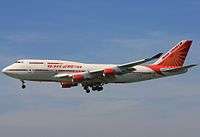
_Air_India_VT-ALD%2C_LHR_London%2C_England_(Heathrow_Airport)%2C_United_Kingdom_PP1369760077.jpg)
